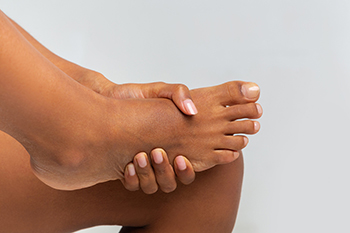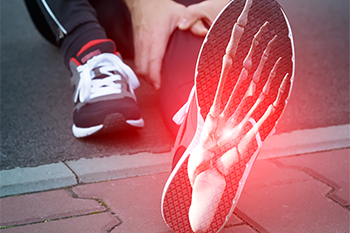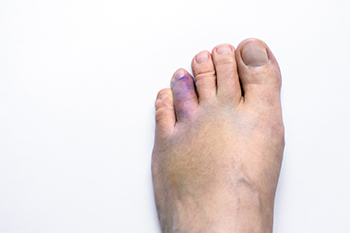
Sore feet can be caused by various factors, including wearing high heels, ill-fitting shoes, and standing for long durations. Pregnancy, flat feet, diabetes, and calluses are other factors. High heels, especially those over two inches, can distort the natural shape of the foot and affect balance, which leads to pain and an increased risk of fractures and ankle sprains. Ill-fitting shoes, whether too tight or too narrow, can irritate the feet, resulting in pain and inflammation. Pregnant women often experience foot pain caused by increased body weight and shifts in their center of gravity. Standing for extended periods of time can result in sore feet, swelling, and inflammation because of the excessive pressure placed on joints and muscles. People with flat feet lack the natural arch that provides support which can lead to sore feet. Lastly, calluses, which are hardened skin areas from stress or pressure, can be painful and inhibit normal walking. A chiropodist can help diagnose and treat these issues, offering relief and improving foot health. If you regularly experience sore feet, it is suggested that you schedule an appointment with a chiropodist.
Foot pain is a common problem treated by chiropodists. If you have foot pain, please consult with one of the specialists from Thornhill Foot Clinic. Our chiropodists can help you maintain the health of your lower limbs and your mobility.
When you are experiencing foot pain, it’s important to note the type of pain and its location, as this can help determine a diagnosis.
Pain in the top of the foot may be caused by:
Stress fractures
Sinus tarsi syndrome
Extensor tendonitis
Tibialis anterior tendonitis
Gout
Athlete’s foot
Ganglion cysts
Pain in the bottom of the foot may be caused by:
Plantar fasciitis
Foot cramps
Tarsal tunnel syndrome
Plantar fibromatosis
Posterior tibial tendonitis
Stress fractures
Flat feet
Pain on the side of the foot may be caused by:
Ankle sprain
Cuboid syndrome
Peroneal tendonitis
Stress fractures
Bunions
Corns or calluses
Posterior tibial tendonitis
Heel pain may be caused by:
Plantar fasciitis
Achilles tendonitis
Bone spurs
Heel fractures
Retrocalcaneal bursitis
Sever’s disease
Pain in the toes may be caused by:
Gout
Hammertoe
Turf toe
Bunions
Ingrown toenails
Blisters
Arthritis
These and many more conditions can be treated by a chiropodist. If you have any questions, please feel free to contact our office located in . We offer the newest diagnostic and treatment technologies for all your foot care needs.
Foot pain is a common symptom of a large variety of injuries and medical conditions. A diagnosis can be narrowed down by describing the locations and type of pain that you are experiencing.
Pain in the heel is often caused by plantar fasciitis, an inflammation of the ligament that runs along the bottom of the foot and connects the heel to the toes. Plantar fasciitis usually causes stabbing heel pains and the pain is at its worst upon arising in the morning or when taking your first steps after a long period of rest. Heel pain can also be caused by heel spurs, bruises on the fat pad of the heel, or heel fractures.
Pain in the ball of the foot can be caused by Morton’s neuroma, in which the tissue of the nerves between the bases of the toes become thickened, causing tingling and numbness. Other causes of pain in the ball of the foot include metatarsalgia or sesamoiditis.
Pain in the arch of the foot can be caused by plantar fasciitis or having flat feet or fallen arches. Pain in the toes can be caused by many conditions, including gout, bunions, hammertoes, ingrown toenails, toe sprains or fractures, arthritis, and corns.
To find out what is causing your foot pain, it is recommended that you consult with a chiropodist, who can diagnose your condition and offer the appropriate treatments.
Running and walking are excellent activities to promote physical fitness and maintain mobility. But whether you are a runner or a walker, finding the right pair of shoes can be difficult. It can be helpful to review how running and walking shoes may differ and what kind of shoes each type of exercise needs.
Runners need shoes that have adequate cushioning in the heel and forefoot. This is because while running, the runner’s feet impact the ground with three times their body weight with each step. When considering the heel of the running shoes, note the heel height and whether or not the heel is flared. Runners need a higher heel than walkers in order to provide them with stability. A flared heel can also help with this. Finally, running shoes need to be flexible. Most running shoes are flexible in the arch or midfoot region, but it’s also possible to find running shoes that are flexible in the forefoot. The best running shoes for you will depend on your gait.
Walkers need shoes that are supportive but do not need the same level of cushioning as runners. The heels of walking shoes don’t need to be as high as those of running shoes, but a flared heel can help walkers with their foot stability as well. Walking shoes also need to be flexible.
With all of this said, walking shoes may be more difficult to find on the market than running shoes. This begs the question: can you walk in running shoes? The answer is yes. However, you should not run in walking shoes. For more information about this topic, please consult with a chiropodist.

Selecting the appropriate shoes for running and walking is essential for comfort and injury prevention, especially considering different foot strike patterns. Heel strikers, who land on their heels first, benefit from shoes with ample cushioning in the rear to absorb impact. Midfoot strikers, who land with their foot flat, need shoes that offer balanced cushioning and support throughout the sole. Forefoot strikers, landing on the ball of their foot, require shoes with extra cushioning in the front. Proper shoes enhance performance and reduce the risk of injuries by aligning with the natural biomechanics of your stride. Investing in footwear tailored to your specific foot strike pattern ensures better support, comfort, and overall foot health. Foot injuries may happen from wearing the wrong type of shoes for the activity. If this applies to you, it is suggested that you consult a chiropodist who can treat various foot conditions, and educate you on appropriate shoes to wear.
Finding the right shoes can sometimes be a major hassle, especially if you intend to work out in them. There are shoes on the market designed specifically for running and walking, but it can be difficult to differentiate between the two and find the right shoes for you. If you’re having trouble finding the right shoes, please consult with one of the specialists from Thornhill Foot Clinic. Our chiropodists can help you maintain the health of your lower limbs and your mobility.
What are the differences between running and walking shoes?
These two types of shoes vary along several parameters.
Cushioning: Runners need more cushioning in the heel and forefoot areas of the shoe, while walkers can get away with less cushioning.
Heel height: Runners need a higher heel to provide them with stability, but the ideal height of the heel for runners varies depending on their running gait. Walkers generally don’t need a built-up heel.
Heel flare: Flared heels can help provide extra stability for runners with certain gaits, while walkers may benefit from a flared heel to control the motion of their foot.
Flexibility: Both runners and walkers need shoes that are flexible.
For more information about the differences between walking and running shoes, and to figure out which shoes may be right for you, please consult with a chiropodist. Feel free to contact our office located in . We offer the newest diagnostic and treatment technologies for all your foot care needs.
If you’re an athlete, you may be familiar with stress fractures. These are tiny cracks in one or more bones of the feet that are caused by repetitive overloading of the foot. This is common in athletes, as frequent training, running, and jumping activities can put a strain on the foot bones. When a stress fracture occurs, symptoms may at first be mild. The affected bone might ache, but only during physical activity. It may disappear with rest. However, if a fracture goes untreated, the pain may increase gradually over time until it hurts constantly and interferes with all weight-bearing activities, like standing or walking. Swelling and tenderness of the areas surrounding the broken bone are also common.
Full fractures occur when one or more bones in the feet crack completely. This is often due to a high-impact injury to the area. Symptoms of a full fracture may include pain, bruising, tenderness, swelling, difficulty walking, and deformity. In some cases, pieces of a broken bone can poke through the skin in an open fracture. This type of fracture requires immediate medical attention due to the high risk of infection.
A chiropodist can diagnose a fracture through an X-ray or bone scan. Treatments may be conservative and include resting, icing, and elevating the foot for a period of time to allow it to heal. Over-the-counter medications may be suggested for pain management. Sometimes you may also be prescribed a brace or other orthotic device to take pressure off the fractured bone while it heals. More severe fractures may require surgery and a lengthy recovery period.
If you’re suffering from a broken foot bone, it’s suggested that you seek the care of a chiropodist.
 Broken toes or feet often result from trauma, such as stubbing the toe, dropping a heavy object on it, or from sports injuries. Immediate first aid is important in managing pain and preventing further damage. First, immobilize the injured area to prevent movement. Use a splint or tape the broken toe to an adjacent toe for support. Elevate the foot above heart level to reduce swelling. Avoid putting weight on the affected foot to prevent further injury. Pain relievers can help to manage pain and inflammation. Seek medical attention from a chiropodist as soon as possible. If you believe you have broken a toe or foot, it is suggested that you visit a chiropodist who can provide a proper diagnosis through physical examination and imaging, like X-rays. They will recommend an appropriate treatment plan, which may include casting, protective footwear, or in severe cases, surgery.
Broken toes or feet often result from trauma, such as stubbing the toe, dropping a heavy object on it, or from sports injuries. Immediate first aid is important in managing pain and preventing further damage. First, immobilize the injured area to prevent movement. Use a splint or tape the broken toe to an adjacent toe for support. Elevate the foot above heart level to reduce swelling. Avoid putting weight on the affected foot to prevent further injury. Pain relievers can help to manage pain and inflammation. Seek medical attention from a chiropodist as soon as possible. If you believe you have broken a toe or foot, it is suggested that you visit a chiropodist who can provide a proper diagnosis through physical examination and imaging, like X-rays. They will recommend an appropriate treatment plan, which may include casting, protective footwear, or in severe cases, surgery.
A foot fracture is a crack or break in a foot bone, often caused by repetitive stress on the foot or a high-impact foot injury. If you’re suffering from foot pain, please consult with one of the specialists from Thornhill Foot Clinic. Our chiropodists can help you maintain the health of your lower limbs and your mobility.
Symptoms
Pain
Bruising
Tenderness
Swelling
Difficulty walking
Deformity
Causes
Repetitive overloading of the foot
Having a previous fracture
Abnormal foot biomechanics
Changing training surfaces suddenly
Poor footwear
Osteoporosis
High-impact injury
Treatments
Rest
Ice
Elevation
Pain medication
Braces or other orthotics
Casts
Crutches
Surgery in more severe cases
If you have any questions, please feel free to contact our office located in . We offer the newest diagnostic and treatment technologies for all your foot care needs.
Ingrown toenails occur when a toenail grows into the surrounding skin rather than over it. This can affect any toe, but most often happens on the big toe. Signs of an ingrown toenail include the surrounding skin becoming tender, painful, swollen, red, and warm. In some cases, the area can become infected, and white or yellow pus may drain from the area. If an ingrown toenail is showing signs of infection, it is recommended that you seek medical treatment.
Ingrown toenails are usually caused by wearing poorly fitting shoes or trimming the toenails improperly. Shoes that are too tight and have narrow, pointed toes or high heels can compress the toes and cause the toenails to curl and grow into the skin. Trimming your nails into a rounded shape or cutting them too short can cause the edges of the nail to grow into the skin. Other potential causes for ingrown toenails include sustaining an injury near the toenail, having a fungal nail infection, using certain prescription medications, and having an abnormal nail shape. Some people also have a genetic predisposition to developing ingrown toenails.
Preventing ingrown toenails begins with proper trimming. Trim your nails regularly using nail clippers rather than nail scissors. Nail clippers cut the nail straight across, avoiding the rounded edges that can make ingrown toenails likely to develop. Make sure that while trimming the nails that you do not cut them too short. Wear comfortable shoes with low heels and a wide toe area to keep your toes from squishing together.
For more information about ingrown toenails, please consult with a chiropodist.

